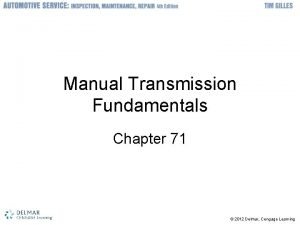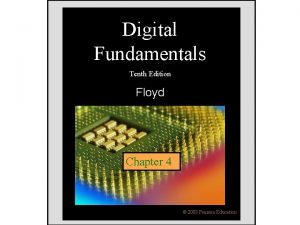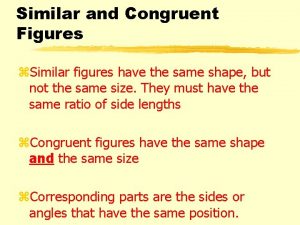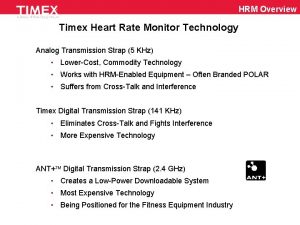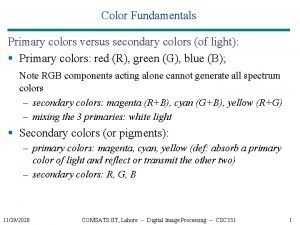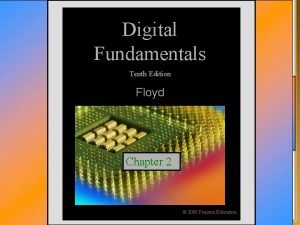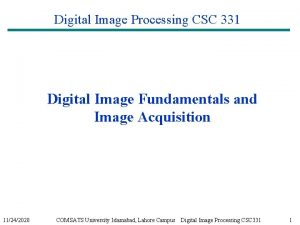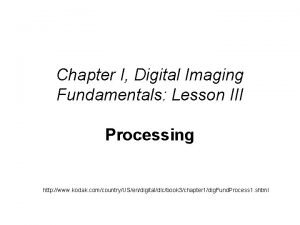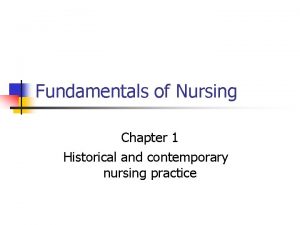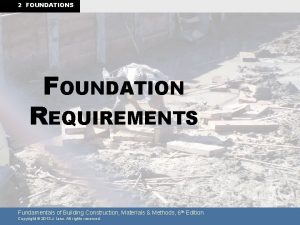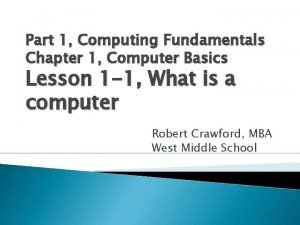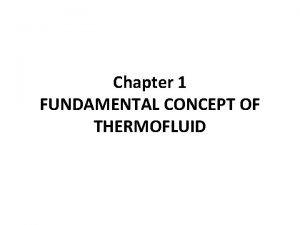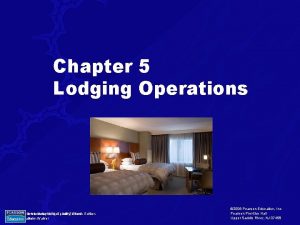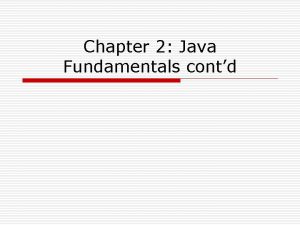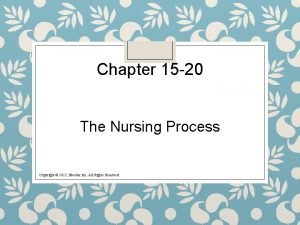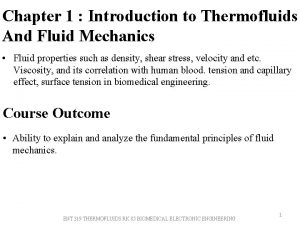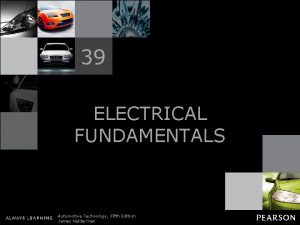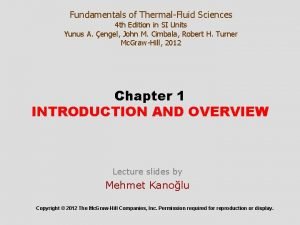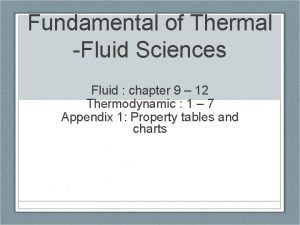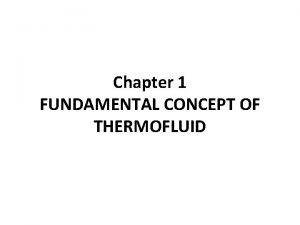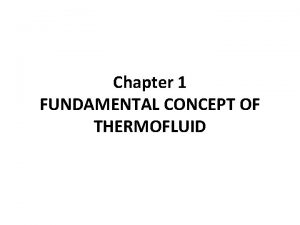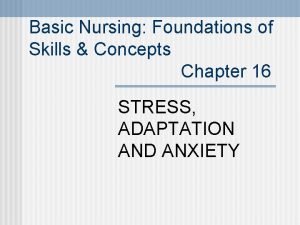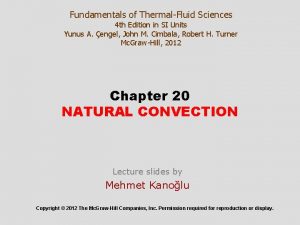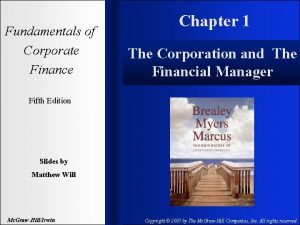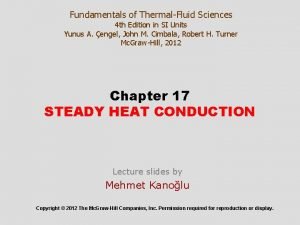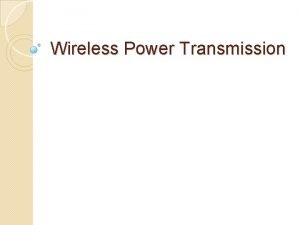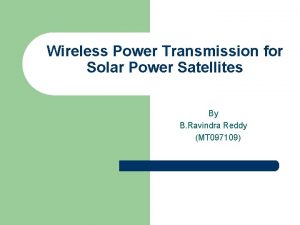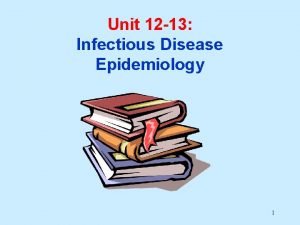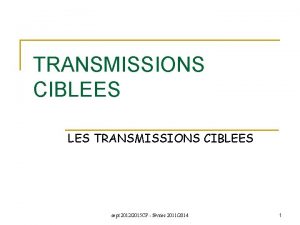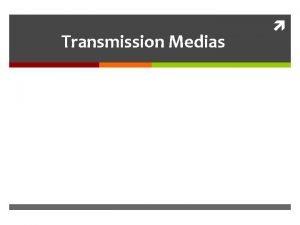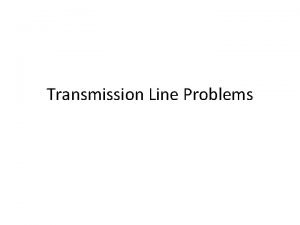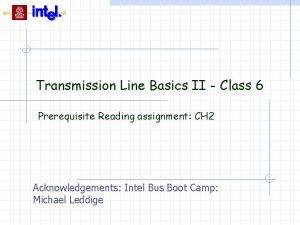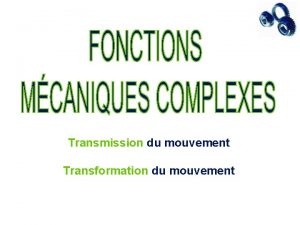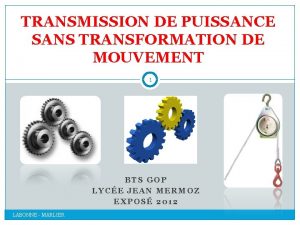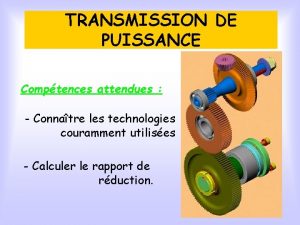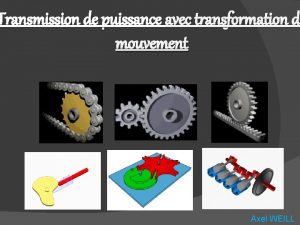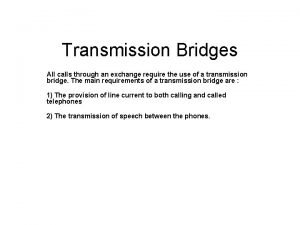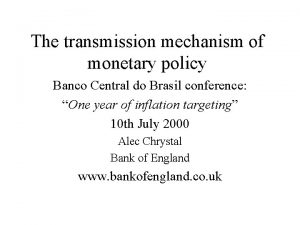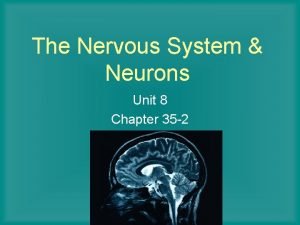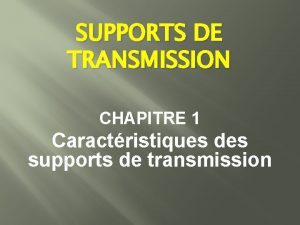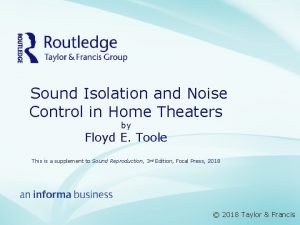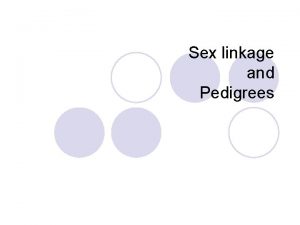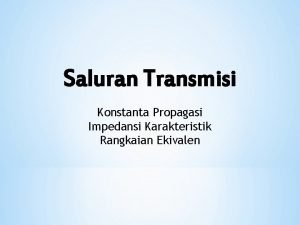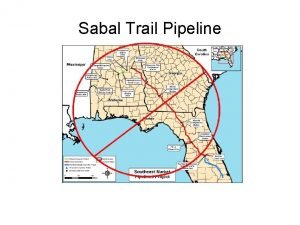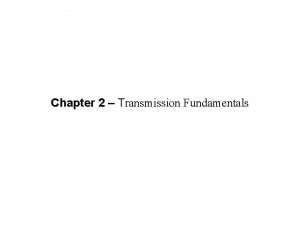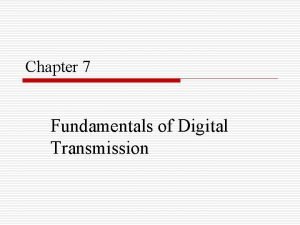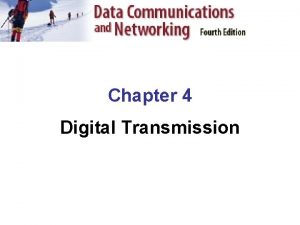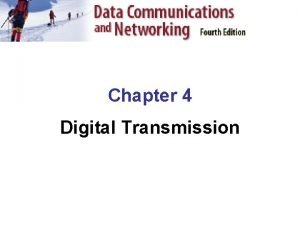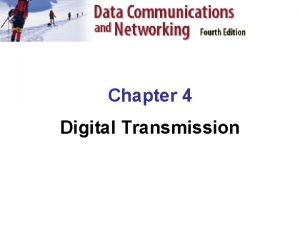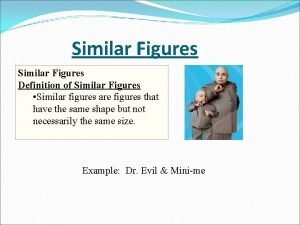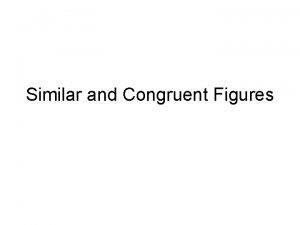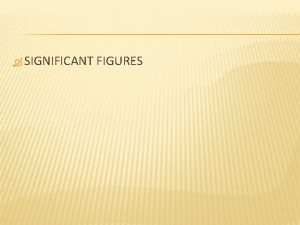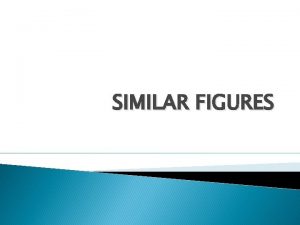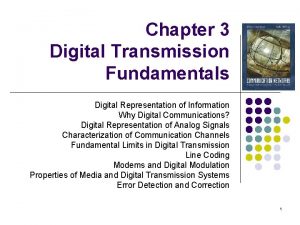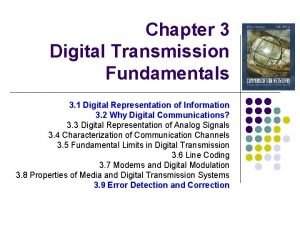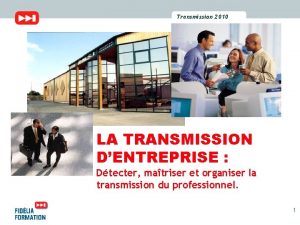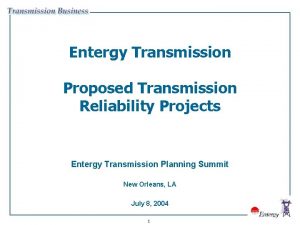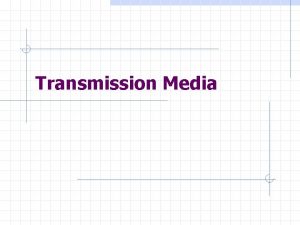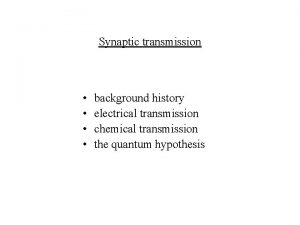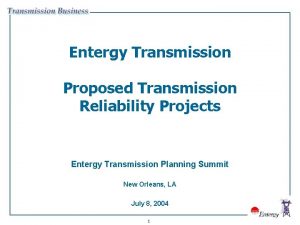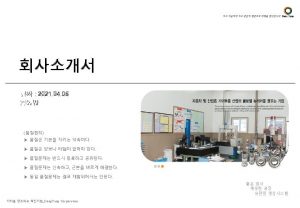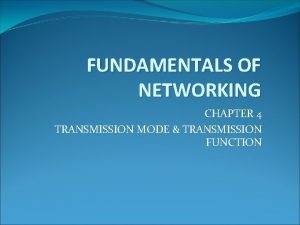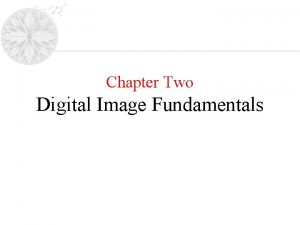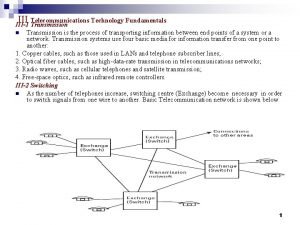Chapter 3 Digital Transmission Fundamentals Chapter Figures W

















































































- Slides: 81

Chapter 3 Digital Transmission Fundamentals Chapter Figures

W H Color image = H W W W Red component image Green component image Blue component image + H Total bits before compression = 3 H W pixels B bits/pixel = 3 HWB Leon-Garcia/Widjaja Communication Networks Figure 3. 1

(a) Original 7 /2 waveform and 5 /2 the sample 3 /2 values /2 -3 /2 -5 /2 -7 /2 (b) Original 7 /2 waveform and 5 /2 the quantized 3 /2 values /2 -3 /2 -5 /2 -7 /2 Leon-Garcia/Widjaja Communication Networks Figure 3. 2

176 (a) QCIF videoconferencing at 30 frames/sec = 144 760, 000 pixels/sec 720 (b) Broadcast TV 480 at 30 frames/sec = 10. 4 x 106 pixels/sec 1920 (c) HDTV at 30 frames/sec = 67 x 106 pixels/sec 1080 Leon-Garcia/Widjaja Communication Networks Figure 3. 3

Transmitter Receiver Communication channel Leon-Garcia/Widjaja Communication Networks Figure 3. 4

(a) Sent Received Examples: AM, FM, TV transmission (b) Sent Received Examples: digital telephone, CD Audio Leon-Garcia/Widjaja Communication Networks Figure 3. 5

Transmission segment Source Leon-Garcia/Widjaja Repeater Communication Networks Destination Figure 3. 6

Attenuated and distorted signal + noise Recovered signal + residual noise Amp Equalizer Repeater Leon-Garcia/Widjaja Communication Networks Figure 3. 7

Decision circuit and signal regenerator Amplifier equalizer Timing recovery Leon-Garcia/Widjaja Communication Networks Figure 3. 8

0110101. . . Leon-Garcia/Widjaja d meters Communication channel Communication Networks 0110101. . . Figure 3. 9

(a) Low-pass and idealized low-pass channel A(f) 1 f f 0 0 W W (b) Maximum pulse transmission rate is 2 W pulses/second Channel t Leon-Garcia/Widjaja t Communication Networks Figure 3. 10

Signal + noise Noise High SNR Noise Signal + noise Low SNR t t SNR = t t Average signal power Average noise power SNR (d. B) = 10 log 10 SNR Leon-Garcia/Widjaja Communication Networks Figure 3. 11

Th e s p ee ch s i g n al l e v el v a r ie s w i th t i m(e) Leon-Garcia/Widjaja Communication Networks Figure 3. 12

Leon-Garcia/Widjaja Communication Networks Figure 3. 13

1 0 1 0 (a) . . . t 1 ms 1 1 0 0 (b) . . . t 1 ms Leon-Garcia/Widjaja Communication Networks Figure 3. 14

(a) Frequency components for 1010 (b) Frequency components for 11110000 Leon-Garcia/Widjaja Communication Networks Figure 3. 15

s (noisy ) | p (air stopped) | ee (periodic) | t (stopped) | sh (noisy) Leon-Garcia/Widjaja Communication Networks Figure 3. 16

X(f) f 0 Leon-Garcia/Widjaja W Communication Networks Figure 3. 17

x(t) x(n. T) t T Leon-Garcia/Widjaja n. T Communication Networks Figure 3. 18

(a) x(t) x(n. T) t t Sampler (b) x(n. T) x(t) t Leon-Garcia/Widjaja Interpolation filter Communication Networks t Figure 3. 19

m bits / sample 2 W samples / sec Analog source Sampling (A/D) Quantization Original x(t) Bandwidth W 2 W m bits/sec Transmission or storage Approximation y(t) Display or playout Interpolation filter Pulse generator 2 W samples / sec Figure 3. 20 Leon-Garcia/Widjaja Communication Networks

Uniform quantizer 3. 5 output y(n. T) 2. 5 1. 5 0. 5 -1. 5 input x(n. T) -2. 5 -3. 5 2. 5 1. 5 0. 5 -1. 5 -2. 5 -3. 5 Leon-Garcia/Widjaja t x(t) and the corresponding quantizer approximations y(n. T) Communication Networks Figure 3. 21

M = 2 m levels, Dynamic Range ( -V, V), Δ = 2 V/M error = y(n. T)-x(n. T)=e(n. T). . . input . . . V -V Mean Square Error: Leon-Garcia/Widjaja x(n. T) Δ σe 2 ≈ 12 Communication Networks Figure 3. 22

Aincos 2 ft Aoutcos (2 ft + (f)) Channel t t A(f) = Leon-Garcia/Widjaja Aout Ain Communication Networks Figure 3. 23

(b) (a) 1 A(f) = 1 1+4 2 f 2 (f) = 0 tan-1 2 f 1/ 2 f f -45 o -90 o Leon-Garcia/Widjaja Communication Networks Figure 3. 24

1 0. 875 0. 625 0. 375 0. 25 1 0 0 0 1 0. 125 0 1. 5 1 0. 5 0 -0. 5 -1 -1. 5 1 ms Leon-Garcia/Widjaja Communication Networks Figure 3. 25

Leon-Garcia/Widjaja Communication Networks Figure 3. 26

h(t) Channel 0 Leon-Garcia/Widjaja t t td Communication Networks Figure 3. 27

s(t) = sin(2πWt)/ 2πWt t T T T Leon-Garcia/Widjaja T T Communication Networks T T T T T Figure 3. 28

1 0 1 1 0 0 T 2 T 3 T 4 T 1 +A 5 T t -A Transmitter Filter Communication Medium Receiver Filter r(t) Receiver Received signal Leon-Garcia/Widjaja Communication Networks Figure 3. 29

(a) T T T t (b) t T Leon-Garcia/Widjaja T T Communication Networks T T T Figure 3. 30

0 Leon-Garcia/Widjaja (1 - )W W (1+ )W Communication Networks f Figure 3. 31

Typical noise Four signal levels Leon-Garcia/Widjaja Eight signal levels Communication Networks Figure 3. 32

0 Leon-Garcia/Widjaja Communication Networks x Figure 3. 33

0 Leon-Garcia/Widjaja 2 4 Communication Networks 6 8 /2 Figure 3. 34

1 0 1 1 1 0 0 Unipolar NRZ Polar NRZ-inverted (differential encoding) Bipolar encoding Manchester encoding Differential Manchester encoding Leon-Garcia/Widjaja Communication Networks Figure 3. 35

Leon-Garcia/Widjaja Communication Networks Figure 3. 36

A(f) 0 Leon-Garcia/Widjaja f 1 fc f 2 Communication Networks f Figure 3. 37

Information (a) Amplitude Shift Keying 1 0 1 +1 -1 0 T 2 T 3 T 4 T 5 T 6 T t +1 (b) Frequency Shift Keying (c) Phase Shift Keying -1 +1 -1 Leon-Garcia/Widjaja t Communication Networks Figure 3. 38 t

1 (a) Information 0 1 1 0 1 +A (b) Baseband signal Xi(t) T 0 2 T 3 T 4 T 5 T t 6 T -A +A (c) Modulated signal Yi(t) 0 2 T T 3 T 4 T 5 T 6 T t -A +2 A (d) 2 Yi(t) cos(2 fct) Leon-Garcia/Widjaja -2 A 0 T 2 T Communication Networks 3 T 4 T 5 T Figure 3. 39

(a) Ak Yi(t) = Ak cos(2 fct) (b) Yi(t) = Akcos(2 fct) Low-pass filter with cutoff W Hz 2 cos(2 fct) Leon-Garcia/Widjaja Xi(t) 2 Ak cos 2(2 fct) = Ak {1 + cos(2 fct)} Communication Networks Figure 3. 40

Ak Yi(t) = Ak cos(2 fc t) Bk + Y(t) Yq(t) = Bk sin(2 fc t) Leon-Garcia/Widjaja Communication Networks Figure 3. 41

Y(t) Low-pass filter with cutoff W/2 Hz 2 cos(2 fc t) 2 sin(2 fc t) Leon-Garcia/Widjaja Ak 2 Akcos 2(2 fct)+2 Bk cos(2 fct)sin(2 fct) = Ak {1 + cos(4 fct)}+Bk {0 + sin(4 fct)} Low-pass filter with cutoff W/2 Hz Bk 2 Bk sin 2(2 fct)+2 Ak cos(2 fct)sin(2 fct) = Bk {1 - cos(4 fct)}+Ak {0 + sin(4 fct)} Communication Networks Figure 3. 42

2 -D signal Bk Ak Ak (a) 4 “levels”/pulse 2 bits/pulse 2 W bits/second Leon-Garcia/Widjaja Bk (b) 16 “levels”/ pulse 4 bits/pulse 4 W bits/second Communication Networks Figure 3. 43

Bk Bk Ak Ak 4 “levels”/pulse 2 bits/pulse 2 W bits/second Leon-Garcia/Widjaja 16 “levels”/pulse 4 bits/pulse 4 W bits/second Communication Networks Figure 3. 44

Frequency (Hz) Leon-Garcia/Widjaja 104 102 10 10 -2 10 -4 10 -6 Wavelength (meters) Communication Networks Gamma rays X-rays Ultraviolet light Visible light 1010 1012 1014 1016 1018 1020 1022 1024 Infrared light Broadcast radio Power and telephone 106 108 Microwave radio 106 102 104 10 -8 10 -10 10 -12 10 -14 Figure 3. 45

d meters Communication channel t = d/v t = 0 Leon-Garcia/Widjaja Communication Networks Figure 3. 46

26 gauge 30 24 gauge Attenuation (d. B/mi) 27 24 22 gauge 21 18 19 gauge 15 12 9 6 3 1 Leon-Garcia/Widjaja 10 100 Communication Networks 1000 f (k. Hz) Figure 3. 47

Leon-Garcia/Widjaja Communication Networks Figure 3. 48

Center conductor Leon-Garcia/Widjaja Dielectric material Braided outer conductor Communication Networks Outer cover Figure 3. 49

35 0. 7/2. 9 mm Attenuation (d. B/km) 30 25 1. 2/4. 4 mm 20 15 2. 6/9. 5 mm 10 5 0. 01 Leon-Garcia/Widjaja 0. 1 1. 0 Communication Networks 10 100 f (MHz) Figure 3. 50

Head end = Unidirectional amplifier Leon-Garcia/Widjaja Communication Networks Figure 3. 51

Upstream fiber Head end Fiber node Fiber Downstream fiber Coaxial distribution plant = Bidirectional split-band amplifier Leon-Garcia/Widjaja Communication Networks Figure 3. 52

Downstream (a) Current allocation 500 MHz 54 MHz Downstream Upstream 750 MHz 550 MHz Communication Networks 500 MHz 54 MHz 42 MHz Leon-Garcia/Widjaja 5 MHz (b) Proposed hybrid fibercoaxial allocation Proposed downstream Figure 3. 53

(a) Geometry of optical fiber Light Cladding Jacket Core (b) Reflection in optical fiber c Leon-Garcia/Widjaja Communication Networks Figure 3. 54

100 50 Loss (d. B/km) 10 5 Infrared absorption 1 0. 5 Rayleigh scattering 0. 1 0. 05 0. 01 0. 8 1. 0 1. 2 1. 4 1. 6 1. 8 Wavelength ( m) Leon-Garcia/Widjaja Communication Networks Figure 3. 55

(a) Multimode fiber: multiple rays follow different paths Reflected path Direct path (b) Single-mode fiber: only direct path propagates in fiber Leon-Garcia/Widjaja Communication Networks Figure 3. 56

Electrical signal Modulator Optical fiber Receiver Electrical signal Optical source Leon-Garcia/Widjaja Communication Networks Figure 3. 57

(a) Single signal per fiber with 1 regenerator per span R R R R (b) DWDM composite signal per fiber with 1 regenerator per span … R R R …R … …R R R (c) DWDM composite signal with optical amplifiers R OA … Regenerator Leon-Garcia/Widjaja OA …R R R OA Optical amplifier Communication Networks DWDM multiplexer Figure 3. 58

Frequency (Hz) 105 104 106 108 107 109 1011 1010 1012 FM radio and TV Wireless cable AM radio Cellular and PCS Satellite and terrestrial microwave LF 10 4 MF 103 HF 102 VHF 101 UHF 1 SHF 10 -1 EHF 10 -2 10 -3 Wavelength (meters) Leon-Garcia/Widjaja Communication Networks Figure 3. 59

All inputs to channel satisfy pattern or condition User Encoder information Leon-Garcia/Widjaja Channel output Channel Communication Networks Pattern checking Deliver user information or set error alarm Figure 3. 60

Received information bits Information bits Recalculate check bits Calculate check bits Leon-Garcia/Widjaja Channel Sent check bits Received check bits Communication Networks Compare Information accepted if check bits match Figure 3. 61

(a) A code with poor distance properties o o x x x o o o x (b) A code with good distance properties x o o x = codewords Leon-Garcia/Widjaja o o x x o o o x o = noncodewords Communication Networks Figure 3. 62

1 0 0 0 1 Last column consists 1 0 0 of check bits for each 1 1 0 row 1 0 0 1 1 1 Bottom row consists of check bit for each column Leon-Garcia/Widjaja Communication Networks Figure 3. 63

1 0 0 0 0 0 0 0 1 1 0 0 One error 1 0 0 Two errors 1 1 0 1 0 0 1 1 1 1 0 0 1 0 0 0 1 1 0 0 Three errors 1 0 0 1 1 0 0 1 1 1 Four errors 1 0 0 0 1 0 Arrows indicate failed check bits Leon-Garcia/Widjaja Communication Networks Figure 3. 64

unsigned short cksum(unsigned short *addr, int count) { /*Compute Internet Checksum for “count” bytes * beginning at location “addr”. */ register long sum = 0; while ( count > 1 ) { /* This is the inner loop*/ sum += *addr++; coun t -=2; } /* Add left-over byte, if any if ( count > 0 ) sum += *addr; */ /* Fold 32 -bit sum to 16 bits */ while (sum >>16) sum = (sum & 0 xffff) + (sum >> 16) ; } Leon-Garcia/Widjaja return ~sum; Communication Networks Figure 3. 65

Addition: Multiplication: x 3 + x 2 + x = q(x) quotient Division: x 3 + x + 1 ) x 6 + x 5 x 6 + x 4 + x 3 divisor x 5 + x 4 + x 3 x 5 + x 3 + x 2 3 35 ) 122 105 17 Leon-Garcia/Widjaja dividend x 4 + x 2 + x x Communication Networks = r(x) remainder Figure 3. 66

Steps: 1. Multiply i(x) by xn-k (puts zeros in (n-k) low order positions) Quotient Remainder xn-ki(x) = g(x) q(x) + r(x) 2. Divide xn-k i(x) by g(x) b(x) = xn-ki(x) + r(x) Transmitted codeword 3. Add remainder r(x) to xn-k i(x) (puts check bits in the n-k low order positions): Leon-Garcia/Widjaja Communication Networks Figure 3. 67

Generator polynomial: g(x)= x 3 + x + 1 Information: (1, 1, 0, 0) i(x) = x 3 + x 2 Encoding: x 3 i(x) = x 6 + x 5 x 3 + x 2 + x 1110 x 3 + x + 1 ) x 6 + x 5 x 6 + x 4 + x 3 1011 ) 1100000 1011 x 5 + x 4 + x 3 x 5 + x 3 + x 2 x 4 + x 2 + x Transmitted codeword: b(x) = x 6 + x 5 + x b = (1, 1, 0, 0, 0, 1, 0) Leon-Garcia/Widjaja 1110 1011 x Communication Networks 1010 1011 010 Figure 3. 68

Encoder for + Clock 0 1 2 3 4 5 6 7 Input - 1 = i 3 1 = i 2 0 = i 1 0 = i 0 0 r 0 = 0 Reg 0 0 1 1 1 0 r 1 = 1 Reg 0 + Reg 1 0 0 1 1 1 0 0 1 r 2 = 0 Reg 2 0 0 0 1 1 1 0 0 Reg 1 Reg 2 Check bits: r(x) = x Leon-Garcia/Widjaja Communication Networks Figure 3. 69

(Transmitter)b(x) + R(x) (Receiver) e(x) Error pattern Leon-Garcia/Widjaja Communication Networks Figure 3. 70

1. Single errors: e(x) = xi 0 i n-1 If g(x) has more than 1 term, it cannot divide e(x) 2. Double errors: e(x) = xi + xj 0 i < j n-1 = xi (1 + xj-i ) If g(x) is primitive, it will not divide (1 + xj-i ) for j-i 2 n-k 1 3. Odd number of errors: e(1) =1 if number of errors is odd. If g(x) has (x+1) as a factor, then g(1) = 0 and all codewords have an even number of 1 s. Leon-Garcia/Widjaja Communication Networks Figure 3. 71

ith position L 4. Error bursts of length b: 0000110 • • • 0001101100 • • • 0 error pattern d(x) e(x) = xi d(x) where deg(d(x)) = L-1 g(x) has degree n-k; g(x) cannot divide d(x) if deg(g(x))> deg(d(x)) L = (n-k) or less: all will be detected L = (n-k+1): deg(d(x)) = deg(g(x)) i. e. d(x) = g(x) is the only undetectable error pattern, fraction of bursts which are undetectable = 1/2 L-2 L > (n-k+1): fraction of bursts which are undetectable = 1/2 n-k Leon-Garcia/Widjaja Communication Networks Figure 3. 72

(a) Single bit input (Transmitter) b + r (Receiver) e Error pattern (b) Vector input (Transmitter) b + r (Receiver) e Error pattern Leon-Garcia/Widjaja Communication Networks Figure 3. 73

0 0 1 1 1 0 0 1 1 s = H e = = 1 1 0 1 0 0 1 1 1 0 0 1 0 1 0 1 1 1 0 0 1 s = H e = = + = 0 1 1 0 1 0 1 1 1 0 0 1 1 0 s = H e = = + + = 0 1 1 1 0 1 0 0 1 1 1 0 0 Leon-Garcia/Widjaja Communication Networks Single error detected Double error detected Triple error not detected Figure 3. 74

s = H r = He 7 p s = 0 No errors in transmission (1–p)7 Leon-Garcia/Widjaja 1– 3 p Undetectable errors 7 p 3 Correctable errors 7 p(1– 3 p) Communication Networks 3 p Uncorrectable errors 21 p 2 Figure 3. 75

b 1 o o b 2 Set of all n-tuples within distance t t = 2 Leon-Garcia/Widjaja Communication Networks Figure 3. 76

L codewords written vertically in array; then transmitted row by row b 1 b 2 b 3 b 4 A long error burst produces errors in two adjacent rows Leon-Garcia/Widjaja . . . b. L-3 b. L-2 b. L-1 b. L . . . Communication Networks Figure 3. 77

13 1 (a) 14 (b) DTE Leon-Garcia/Widjaja 25 1 Protective Ground (PGND) 1 2 Transmit Data (TXD) 2 3 Receive Data (RXD) 3 4 Request to Send (RTS) 4 5 Clear to Send (CTS) 5 6 Data Set Ready (DSR) 6 7 Ground (G) 7 8 Carrier Detect (CD) 8 20 Data Terminal Ready (DTR) 20 22 Ring Indicator (RI) 22 Communication Networks DCE Figure 3. 78

Data bits Line idle Start bit 1 2 3 4 5 6 7 8 3 T/2 T T T Stop bit T Receiver samples the bits Leon-Garcia/Widjaja Communication Networks Figure 3. 79

X(f) 0 -W X(f + 1/T) f W X(f) X(f – 1/T) … … – 1 T –W 0 W X(f) X(f + 1/T) f X(f – 1/T) … … –W Leon-Garcia/Widjaja 1 T 0 Communication Networks W f Figure 3. 80
 Describe manual transmission fundamentals.
Describe manual transmission fundamentals. Digital fundamentals chapter 4
Digital fundamentals chapter 4 Congruent symbol
Congruent symbol Plane shape
Plane shape Coordinate plane jeopardy
Coordinate plane jeopardy Disadvantages of digital transmission
Disadvantages of digital transmission Data encoding and modulation
Data encoding and modulation Analogue and digital transmission
Analogue and digital transmission Analog and digital signals in computer networking
Analog and digital signals in computer networking Timex digital flex tech hrm sensor
Timex digital flex tech hrm sensor Digital fundamentals by floyd
Digital fundamentals by floyd Digital fundamentals 10th edition
Digital fundamentals 10th edition Color fundamentals in digital image processing
Color fundamentals in digital image processing Digital fundamentals floyd 10th edition
Digital fundamentals floyd 10th edition Digital fundamentals answers
Digital fundamentals answers Digital image fundamentals
Digital image fundamentals Digital imaging fundamentals
Digital imaging fundamentals Jelaskan warga digital
Jelaskan warga digital Digital goods ecommerce
Digital goods ecommerce Digital data digital signals
Digital data digital signals E-commerce: digital markets, digital goods
E-commerce: digital markets, digital goods Digital data to digital signal encoding
Digital data to digital signal encoding Luxembourg digital innovation hub
Luxembourg digital innovation hub Unique features of digital markets
Unique features of digital markets Puncture resistant container
Puncture resistant container Chapter 19 disease transmission and infection prevention
Chapter 19 disease transmission and infection prevention Chapter 15 infection control
Chapter 15 infection control Chapter 19 disease transmission and infection prevention
Chapter 19 disease transmission and infection prevention Fundamentals of nursing chapter 1 notes
Fundamentals of nursing chapter 1 notes Fundamentals of electric circuits chapter 4 solutions
Fundamentals of electric circuits chapter 4 solutions Fundamentals of corporate finance chapter 6 solutions
Fundamentals of corporate finance chapter 6 solutions Conceptual physics magnetism
Conceptual physics magnetism Chapter 73 tire wheel and wheel bearing fundamentals
Chapter 73 tire wheel and wheel bearing fundamentals Understanding your health and wellness chapter 1
Understanding your health and wellness chapter 1 Fundamentals of electric circuits chapter 9 solutions
Fundamentals of electric circuits chapter 9 solutions Fundamentals of electric circuits chapter 7 solutions
Fundamentals of electric circuits chapter 7 solutions Fundamentals of building construction chapter summaries
Fundamentals of building construction chapter summaries Computer fundamentals chapter 1
Computer fundamentals chapter 1 Fundamentals of corporate finance chapter 1
Fundamentals of corporate finance chapter 1 Fundamentals of thermal-fluidsciences chapter 1 problem 25p
Fundamentals of thermal-fluidsciences chapter 1 problem 25p Fundamentals of information systems chapter 1
Fundamentals of information systems chapter 1 Fundamentals of information systems
Fundamentals of information systems Fundamentals of nursing chapter 17 vital signs
Fundamentals of nursing chapter 17 vital signs Forensic science fundamentals and investigations chapter 6
Forensic science fundamentals and investigations chapter 6 Lodging operation in hospitality industry
Lodging operation in hospitality industry Chapter 2 lab java fundamentals
Chapter 2 lab java fundamentals Back channeling nursing
Back channeling nursing Fundamentals of thermal-fluidsciences chapter 1 problem 9p
Fundamentals of thermal-fluidsciences chapter 1 problem 9p Chapter 39 electrical fundamentals
Chapter 39 electrical fundamentals Fundamentals of thermal-fluidsciences chapter 1 problem 10p
Fundamentals of thermal-fluidsciences chapter 1 problem 10p Fundamentals of thermal-fluidsciences chapter 2 problem 1p
Fundamentals of thermal-fluidsciences chapter 2 problem 1p Critical thinking model nursing
Critical thinking model nursing Understanding your health and wellness chapter 1
Understanding your health and wellness chapter 1 Fundamentals of thermal-fluidsciences chapter 1 problem 18p
Fundamentals of thermal-fluidsciences chapter 1 problem 18p Fundamentals of thermal-fluidsciences chapter 1 problem 16p
Fundamentals of thermal-fluidsciences chapter 1 problem 16p Fundamentals of nursing chapter 16
Fundamentals of nursing chapter 16 Grashoff number
Grashoff number Fundamentals of corporate finance, chapter 1
Fundamentals of corporate finance, chapter 1 Fundamentals of thermal-fluidsciences chapter 2 problem 30p
Fundamentals of thermal-fluidsciences chapter 2 problem 30p Fundamentals of thermal-fluidsciences chapter 2 problem 24p
Fundamentals of thermal-fluidsciences chapter 2 problem 24p Chapter 23 computer system fundamentals
Chapter 23 computer system fundamentals Air ionization in wireless power transmission
Air ionization in wireless power transmission Wireless power transmission project report doc
Wireless power transmission project report doc Transmission model of communication
Transmission model of communication Infectivity definition
Infectivity definition Transmission ciblée
Transmission ciblée Guided media
Guided media Lossless transmission line examples
Lossless transmission line examples Transmission line examples
Transmission line examples Transformation de mouvement
Transformation de mouvement Transmission de puissance
Transmission de puissance Transmission de puissance
Transmission de puissance Transformation de mouvement par excentrique corrigé
Transformation de mouvement par excentrique corrigé Transmission bridge
Transmission bridge Transmission of monetary policy
Transmission of monetary policy Nerve impulse transmission steps
Nerve impulse transmission steps Support de transmission cable coaxial
Support de transmission cable coaxial Sound transmission loss
Sound transmission loss Solar power satellites and microwave power transmission
Solar power satellites and microwave power transmission Linked
Linked Contoh saluran transmisi
Contoh saluran transmisi Sabal trail transmission
Sabal trail transmission
